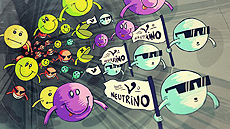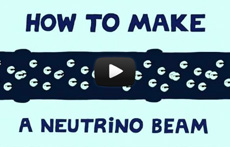How to make a neutrino beam
 |
Neutrinos are elusive particles that are difficult to study, yet they may help explain some of the biggest mysteries of our universe. Using accelerators to make neutrino beams, scientists are unveiling the neutrinos' secrets. Image: Sandbox Studio
|
Neutrinos are among the most abundant particles in the universe, but they rarely interact with matter. Some of today's outstanding scientific mysteries, such as why there is more matter than antimatter in the universe, could be solved by studying neutrinos and detecting their interactions with matter.
Billions of neutrinos from natural sources, including the Sun, zip through every square centimeter of the Earth each second. Yet scientists cannot easily determine their initial type or exactly how far they traveled before reaching a detector.
To study neutrinos more effectively, scientists produce high-intensity neutrino beams using proton accelerators. Only a few laboratories in the world can manufacture such neutrino beams: the J-PARC laboratory in Japan, the research center CERN in Europe and Fermi National Accelerator Laboratory in the United States. Every two seconds, Fermilab fires a trillion neutrinos toward particle detectors located in northern Minnesota, more than 450 miles away. This intense beam produces about a thousand neutrino interactions per year in the detectors.
Scientists make high-intensity neutrino beams by starting with batches of protons from a bottle of hydrogen gas. They accelerate each batch to nearly the speed of light and smash it into a target, usually made of graphite or beryllium. The protons shatter the target's atomic nuclei and produce new particles, including short-lived pions—the source for neutrinos and anti-neutrinos.
Powerful focusing horns, which produce strong, carefully aligned magnetic fields, redirect the pions so they are all traveling in roughly the same direction, creating a meter-wide beam of either positively or negatively charged pions. Positively charged pions, which live for only a fraction of a second, decay into anti-muons and muon neutrinos; their equally short-lived, negatively charged brothers decay into muons and muon anti-neutrinos.
Blocks of aluminum, steel and concrete are the final steps to create a pure neutrino (or anti-neutrino) beam. The blocks stop and absorb all particles except the ghost-like neutrinos (or anti-neutrinos), which pass through unchanged. Ta da!
Read more
 |
View an animation on how a neutrino beam is made. Animation: Sandbox Studio
|
—Jessica Orwig
|